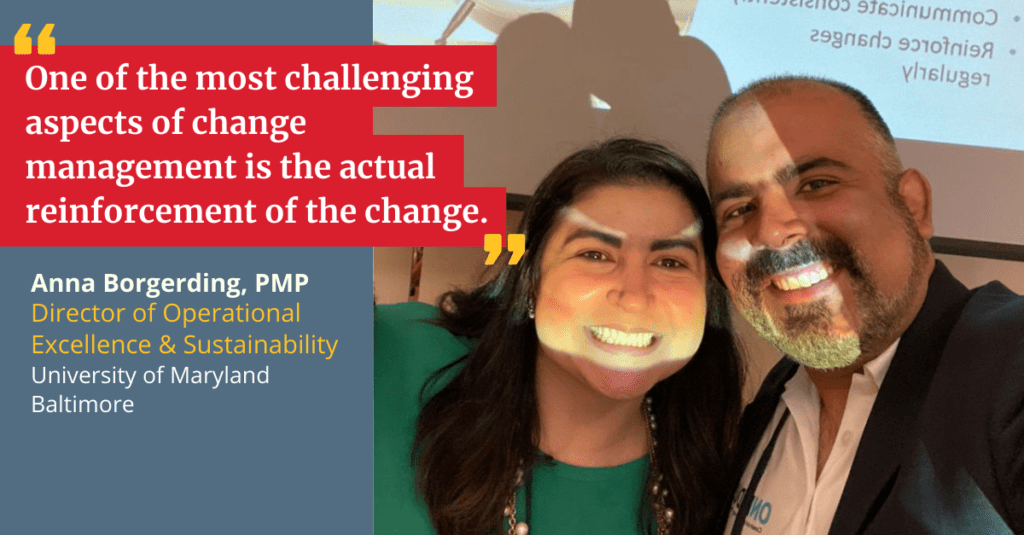Whether it’s welcoming a new leader to the team or a modification in the project strategy, organizations evolve through changes. How you manage these changes makes a difference in your organizational culture. Effectively managing change normalizes the ripple effects caused by the change and helps the team members to adapt to responsibilities, goals, and work culture with fewer difficulties.
The core idea of change management is to neutralize the operational impacts by understanding how the modifications and adjustments will affect processes, systems, and teams within the company. A change management strategy can significantly reduce the aftereffect by planning, testing, communicating, scheduling, implementing, and documenting the changes.
Anna Borgerding, PMP, is the Director of Operational Excellence & Sustainability at the University of Maryland, Baltimore. She manages projects and guides leaders as they plan and implement changes in business processes and technology. She has over 10 years of experience in implementing standard operating procedures, business process improvement, and construction project management.
During the COAA Connect 2022 Conference, we caught up with Anna about her thoughts on how changes are perceived and reinforced throughout the organization. “There’s a significant benefit long term to the organization when you bring everyone along with change management and help them adapt one person at a time,” said Borgerding.
Why Does A Company Need Change Management?
One of the major aspects that most project managers tend to neglect is the impact of change on the people in the organization. Most project leaders only focus on the change that will affect the project deadlines and cost, but many forget to evaluate how the people directly affected by it will perceive the change.

According to Borgerding, one of the first steps to deciding whether you need change management is asking yourself, “Are you adjusting your business as usual? It can be a tweak or it can be an overhaul.” She said that change management is needed even if you are asking people to do something in a different way, even if it’s just thinking differently. “Another component
would be to ask if you are affecting people other than yourself. Change management should be included when you’re impacting others.”
The business needs to adjust to the new changes on various fronts. If you plan to ask people to do something different regarding their responsibilities, the changes need to be communicated and reinforced correctly to maximize the effect and minimize confusion. That’s why you need change management strategies in place. It especially helps determine and neutralize the impact on people involved in the project.
To what extent can change management impact the overall business outcome?
Organizational changes are imminent, but poorly-planned implementation can disrupt your steady operations. This also emphasizes how change management can affect the business outcomes, costs, and deadlines. As per Borgerding, “The changes impact a company from qualitative and quantitative perspectives.”
The quantitative impact is often hidden in the metrics. The project dashboards offer numerous metrics that define the successful completion of project milestones. That’s when the metrics become the indicators of business output. The quantitative impact is observed through the reports and metrics offered by the centralized system, such as a change management system dashboard.
The intelligence generated through the system in terms of reports and metrics provides the necessary foundation to determine the qualitative impact of the changes. It determines how the changes are reinforced in the operations, are the team members aware of their new responsibilities, and do they need training and additional resources? It also includes one-on-one feedback to get more personalized solutions that can maximize the change implementation. These effects last longer and are more sustainable. With time, you can build a strong team that can easily adapt to new changes without impacting the operations.
What are the most commonly ignored or challenging aspects of change management?
According to Anna, “One of the most challenging aspects of change management is the actual reinforcement of the change.” Owners often struggle to maintain the same momentum when the changes are introduced and planned. The team members are assigned updated responsibilities and are trained for the same, but within a few weeks, everything seems to cool down. The changes must be flawlessly incorporated into the standard procedures and need to reflect in the work culture. That way, the project doesn’t lose steam and the organization can effectively deal with and adapt to the changes for good.
Documentation, which is one of the core change management processes, is often not paid enough attention to. But in many cases, documentation helps keep an audit trail and works as a backup plan if a rollback becomes evident. It also ensures that all the internal and external compliances are fulfilled along with legal regulations.

As highlighted by Sid Shah, CEO of OnIndus, in a conversation with Anna Borgerding, “The other most challenging aspect of change management is reinforcing repeated communications long after the change was implemented.” The team members are promised to receive top-notch training, resources, and support, but the essential element is often ignored i.e. communication. Most teams, irrespective of their size, often lack the same understanding of the project’s goals. This goal ambiguity can pull the projects back significantly. Despite regular training sessions and meetings, team members might miss the essence of the goals and keep working on a different version of the goals. “Clear communication, follow through, and regular avenues for feedback to adjust the change strategy all reinforce the organizational change for the long term,” Anna stated.
In such cases, patience, better communication, and effective reinforcement can go a long way in aligning the changes with the business goals. All the stakeholders are brought back into the conversation for more clarity on the situation so they don’t operate in separate realities and get everyone on the same page.
Final thoughts
Organizational changes can be frustrating, even catastrophic at times. But if the changes are planned, scheduled, and communicated strategically across all the individuals involved in the project, the change can bring more output and achieve sustainable growth. With the right resources, like a change management platform and experienced change management consultants, the organization can ensure a hassle-free and smooth transition.
Many organizations undermine the role of project managers and external consultants in minimizing the overall impact and ensuring a successful implementation of change. That’s where OnIndus can help you. To understand how OnIndus can help your team observe, develop, and execute best-in-class processes for change management, contact us via email (connect@onindus.com) or call us directly at +1 786 472 4840.

